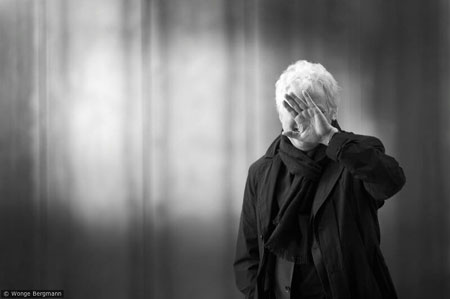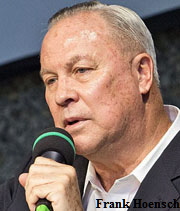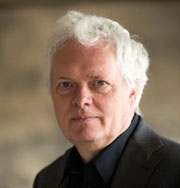|
American theatergoers interested in the ultra experimental know about such work as Einstein on the Beach by Robert Wilson and Philip Glass, but probably not the work of German composer-director-professor Heiner Goebbels. Gertrude Stein has significantly influenced both Wilson and Goebbels.
In 2004 while doing research on theater that came from Stein’s influence, the Steiny Road Poet became aware of Goebbels and his music
theater piece Hashirigaki. Hashirigaki, meaning flowing writing, premiered in 2000. Steiny’s research was documented here at Scene4 Magazine. Hashirigaki,
mixing excerpts from Stein’s long novel The Making of Americans with music of Beach Boys Brian Wilson’s Pet Sounds as well as traditional Japanese music, has been performed numerous times all over the world. Laura Luise Schultz, one of the editors of Stein’s Stanzas in Meditation: The Corrected Edition recently reminded Steiny of Goebbels connection to Stein when she told Steiny he had lectured several times in Copenhagen (where Schultz is based) as well as mounted a staged concert based on Stein’s Wars I Have Seen.
Goebbels, through translators David Roesner and Christina M. Lagao, has published Aesthetics of Absence: Texts on Theatre (London and New York: Routledge, 2015), a first English translation of writings and lectures by Goebbels that reflect on 20 years of his staged work, a look at other artists who have influenced him (including Gertrude Stein, Robert Wilson, Bertolt Brecht, Hanns Eisler, and others), and educational tips for theatrical direction.

In the first chapter (pp. 4-5), Goebbels discusses eleven concepts of the “theatre of absence.” Among these concepts are:
the disappearance of the actor or performer either on stage or in the central focus of the play; a polyphony of elements, such as
lightning, the space, the text, a fugue by J. S. Bach; performers who hide their significance, for example by turning their backs
on the audience; separation of the actors’ voices from their bodies and musicians’ sounds from their instruments; de
-synchronization of hearing and seeing caused by a separation or division between the visual and acoustic stage (something that
can be achieved with a live video feed of action offstage); removal of the drama from the stage to another location; avoidance of things expected.
What is remarkable about Aesthetics of Absence is how open Goebbels is in illuminating his creative process and how others
have influenced him. In a lecture delivered in 2011 to The European Graduate School on the theatre of absence, he said he
did not mind if people did not understand the language of the text he chose. Then he quoted Gertrude Stein discussing her
experience of Sarah Bernhardt performing in French in a play in San Francisco. Stein was 16 years old and spoke a little French
but she did not mind that she did not understand much of what Bernhardt delivered, because she was taken by the rhythm and
delivery of the words. For her, the style of theater was a thing in itself and she found it very pleasurable. Goebbels found Stein’s
reaction freeing and this fed his theatre of absence.
While talking in his new book about Robert Wilson’s immense contribution to modern day theater, Goebbels proffers (p. 63):
“We owe him [Robert Wilson] a lot for the pleasurable insight that there is another way. And I mean nothing less than the fact
that his work has changed my life, for instance—even more than once.

“I owe him also the physical experience that in theatre ‘time’ can
be an artistic and artificial time out—not a professed reality. That lighting is an independent art form that you can observe
like a natural spectacle creating an untold drama when a shadow inexplicably turns red. Or that, just like in the movies, ‘close ups’
are possible to create with light on stage (by lighting just one finger).
“I also owe him the experience of how it feels to think from the
spectators’ sovereignty. Not to clutter the stage with ideas, but to keep it open. Maybe I learnt from him, that as an audience
member I’m not really interested in how much imagination the director or stage designer has, but rather whether they succeed
to open up the space for the spectators’ imaginations.”

Heiner Goebbels is an international artist who often lectures in English. He values audience that is curious and unprepared for
the surprises that Goebbels’ theater might present. While he came from a musical family and formally studied music, his
undergraduate studies began with sociology. Born in 1952, Goebbels was concerned about dealing with German history that
had been repressed in the postwar years relative to what sounds and images a German was allowed to use. He said certain words,
particularly in German, carried too much baggage. In an interview with Nicholas Till (The Wire (GB), March 2003, Issue
229), Goebbels said, “With a name like [mine], [I] couldn’t escape at least some unwelcome historical reminders…”
Perhaps, this is the root of Heiner Goebbels’ theater of absence.
Research on theater that came from Stein’s influence
|